

Soil Biology Movies. 4.3 VAM - the beneficial fungi that feed plants. By Sally Smith, University of Adelaide Most plants do not just have roots, they have VAMs - vesicular arbuscular mycorrhiza. VAMs are fungi which live in a harmonious relationship with plant roots. This is a symbiosis in which the fungi provide the plant with extra nutrients from the soil, especially phosphorus and zinc, in exchange for sugars provided by the plants. About 80% of all plants, including most field crops and many trees, harbour the fungi as an integral and normal component of their root systems.
As with all fungi VAMs also help hold soil particles together. How VAMS live VAM fungi grow inside plant roots. Summer: plants absent. After rain VAM germinates from dead root fragments and spores-colonising new roots. Some plants, especially trees like Eucalypts, orchids and some heathland shrubs, have a different type of symbiotic fungus which works in a similar way to VAM. Can I see VAM in soil or roots? VAMs cannot be seen unless the root is stained and viewed under a microscope.
Rye. SOIL ECOLOGY. I.

Life in the soil microscopic -------macroscopic Soil ecology: The study of the relationship between organisms in the soil environment II. Producers, Consumers and Decomposers • Decomposers are critical for life • Microbes: major decomposers, responsible for Mineralization III. 1. . • 107-1010/gram of soil. Introduction to Soil Microbiology. LAB MANUAL, EXERCISE #22: Soil Microbiology & Elective Culture. NAME of TA: ______________________________ Nitrogen is one of the major # for all forms of life as it is required to make proteins and nucleic acids as well as a variety of other constituents of living organisms.
Although our atmosphere is 70% nitrogen gas (N 2 ), the majority of life forms can only utilize nitrogen in a "fixed" or combined form. The most common fixed forms of nitrogen include proteins, nucleic acids, ammonia, nitrate and nitrite. Although N 2 may be fixed non-biologically, it is not a very efficient process and it is unlikely that life could exist on earth (at least as we know it) if this was the only source of fixed nitrogen. It is reasonable to assume that the fixed nitrogen that existed on earth when the first living cell (# C-prime ) was formed would have relatively quickly (maybe a million years, give or take a few 100,000) become a limiting nutrient. D-mannitol Carbon source, Energy 10 gms Phosphate, Potassium 0.5 gms MgSO 4 .7H 2 O Magnesium, Sulfur 0.1 gms NaCl 0.2 gms. SustainableStudies.
Soil food web - opening the lid of the black box. We know more about the movement of celestial bodies than about the soil underfoot. - Leonardo da Vinci, circa 1500s Any sufficiently advanced technology is indistinguishable from magic. - Arthur C.

Clarke "Magic" is how humans have customarily described the soil's natural cycles of decay and growth. Without a scientific understanding, our ancestors relied on observation and traditional practices to grow crops. Modern chemical agriculture has been only marginally better at understanding the soil. In contrast, organic methods like permaculture have attempted to work with natural cycles.
Recently, however, soil ecology has developed to the point where we can open the lid on the black box of underground processes. It is no longer just compost-lovers who are excited about soil. "In many ways the ground beneath our feet is as alien as a distant planet. Waiting for Dr. It's a chilly winter day at the San Mateo Garden Center in Northern California. At last Dr. Dr. Soil food web Symbiotic Fungus: